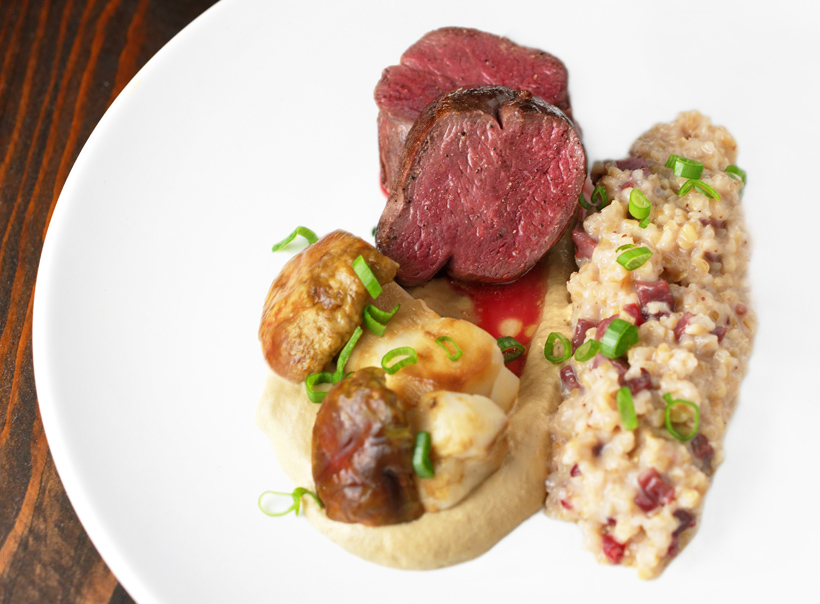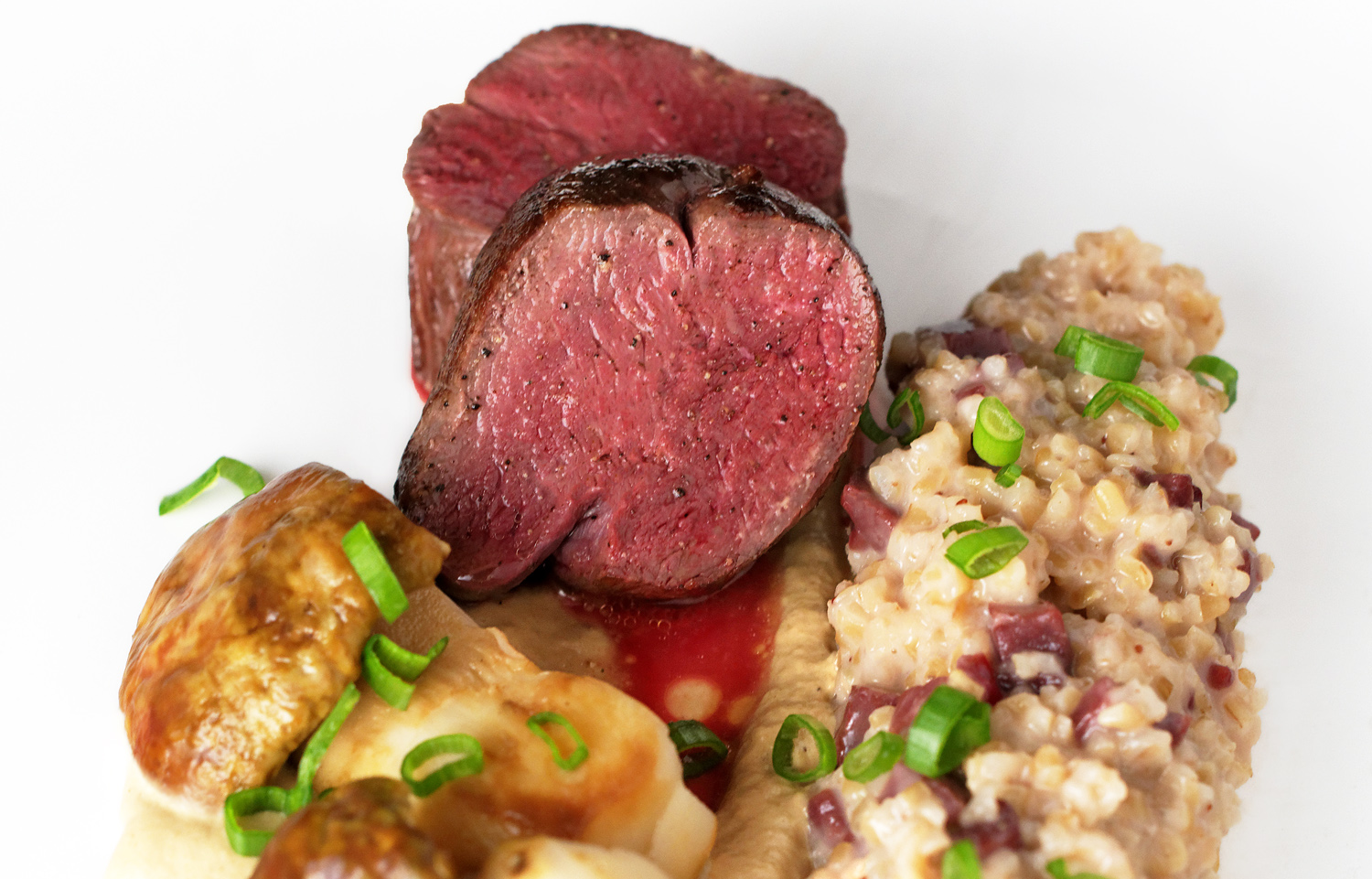Last month, during a short business trip to Sweden, I visited Stockholm’s venerable Östermalms Saluhall, a food market operating since 1888. While the historic hall is currently closed for renovation, the market has been transplanted to another building nearby. I was searching for something very specific and quite unique, something that you can’t acquire in many places around the world: reindeer meat.
Reindeer, also known as caribou in North America, is mostly native to arctic and subarctic regions. It’s the only domesticated deer in the world, although semi-domesticated would be more accurate, and even then substantial commercial herds are mostly found in northern Norway, Sweden, Finland, and Russia. Perhaps one used to be able to find caribou in Canadian butcher shops and restaurants, but this seems to be no longer the case, as caribou populations have declined sharply there. And if Alaska herds reindeer, they don’t seem to sell too much of it on the internet, and what they sell is typically limited to sausages, ground meat, and meat shavings. Boring! Unless you want to buy live reindeer, which you can do here.
Which leaves us only with northern Russia and the Fennoscandian Peninsula. Only the former is the subject of this blog, but the latter provides much easier access; as in, direct flights from almost anywhere and good availability in stores. At the Östermalms Saluhall, for example, you can buy beautiful reindeer tenderloins and other steaks, reindeer salami, and smoked reindeer.




So what does reindeer meat taste like? Should you really hop on the first plane to Sweden and stock up on chopped, vacuum-sealed Rudolph? To tell you the truth, it’s not that different from other Cervidae. I’ve had reindeer steaks and tartares several times both during and after my trip, and cannot claim that I’ve identified a taste specific to reindeer. Don’t get me wrong — I love it, but I suspect that the animal’s feed plays an important role, and no two reindeer meals I ate really tasted the same. The tenderloin and the steaks tasted somewhat gamey and were quite tender. The cold-smoked reindeer fillet was very, very smoked, to the point where it just felt like a vehicle for the smoke — pleasant, but only when consumed in small amounts. The reindeer salami was a good dried sausage, again with a taste similar to other venison sausages I’ve tried in the past.
Still, an altogether excellent reason to explore the cuisine of the northern confines of Russia. I’ve created a dish that uses several recurring ingredients of this harsh country: reindeer, of course, but also wild mushrooms (often marinated), lingonberries, and smoked meat. I also took inspiration from a recipe I found in Russia’s Cooking: Tradition and Modernity.That recipe was created by brothers Ivan and Sergey Berezutsky, who are currently running a couple of restaurants in Moscow (Twins and Wine & Crab) and at some point seem to have created a series of dishes inspired by Russia’s Northwest, from Murmansk to Karelia.

Porcini purée
Yields 4 servings
135 g porcini, medium dice
20 g butter
salt
black pepper, ground
55 g hard cider
40 g heavy cream
- In a saucepan over medium heat, sauté the porcini in the butter. Season with salt and pepper, and cook until golden brown.
- Add the hard cider, and reduce by half.
- Transfer to a blender, add the cream, and process until smooth. Reserve.
Bulgur base
Yields 4 servings
120 g bulgur
200 g beef stock
160 g milk
40 g heavy cream
15 g grated parmesan
- In a small saucepan over low heat, bring the bulgur, stock, and milk to a simmer, stirring regularly. Cover with a lid, and cook for about 15 minutes, or until the bulgur is tender.
- Mix in the cream and parmesan, and reserve.
Assembly
Yields 4 servings
500 g cleaned reindeer tenderloin
transglutaminase (optional, see below)
canola oil
salt
40 g butter
black pepper, ground
200 g marinated porcini (about 1 pint jar)
bulgur base
about 30 g beef stock
80 g lingonberry preserves
70 g cold-smoked reindeer, small dice
porcini purée
scallion green, thinly sliced
- If you want to shape your reindeer fillets into nice medallions, use transglutaminase. You can find detailed instructions here. Basically, you need to sprinkle transglutaminase on the parts of the meat you want to bind together, shape the medallions using plastic wrap (i.e., form long cylinders that you will slice before serving), and refrigerate for at least 5 hours.
- Heat some canola oil in a pan over high heat. Season the meat with salt, and sauté until brown on all sides.
- Transfer the meat to a sous-vide pouch (or to a couple of pouches), add the butter, and vacuum-seal. Cook in a 49 C / 120 F water bath for 1 hour.
- Take the meat out of the pouch, reserving the jus for later. Again, heat some canola oil in a pan over high heat, and quickly sauté the tenderloins on all sides to brown them a little bit more. Remove from the heat, season with salt and pepper, and let rest for a few minutes.
- Sauté the marinated porcini in the same pan over low heat for a couple minutes, and season with black pepper.
- In a saucepan over medium heat, reheat the bulgur with a little bit of beef stock. Remove from the heat, then mix in the lingonberry preserves and smoked reindeer.
- Reheat the porcini purée in a small saucepan over medium heat (or in the microwave).
- Cut the reindeer into medallions (two medallions per person in my case), and pour some of the reserved jus on top.
- On each plate, draw a thick line of porcini purée, and top it with some sautéed porcini and reindeer medallions. Parallel to that line, form another thick line of lingonberry bulgur. Sprinkle with scallions, and serve.



9 comments
Avec de la biche, c’est la même cuisson????
Oui
Meme temps, meme temperature?
Si le filet est de la même taille, absolument!
Merci Florian! Si j’ai d’autre questions je n’hésiterais pas à BOURRER cette section de commentaires utiles
-Cepes : une alternative si on trouve pas de cèpe?
-hard cider : on peut mettre du vrai cidre ou bien faut se taper de la pisse d’âne sucrée?
-On peut préparer la sauce un peu d’avance?
-200 g beef stock : j’utilise la recette du bouillon de pelmenis?
-200 g marinated porcini : on peut en mettre des pas marinés?
-70 g cold-smoked reindeer : j’ai pas, je remplace par quoi?
-Je peux faire cuire mon roti sous vide en une fois?
-porcini purée c’est la porcini sauce? Faudrait savoir, on s’y perd.
– Achete des cepes surgeles, ca se trouve assez facilement.
– Hard cider = cidre en France.
– Oui.
– Pourquoi pas.
– Je croyais que tu n’allais pas en trouver (voir premiere question)…. Les cepes marines, eux, se trouvent assez facilement.
– Par une autre viande fumee ou du jambon de pays.
– Pas compris.
– Oui, merci pour la correction.
“-Je peux faire cuire mon roti sous vide en une fois?” Faut pas que je le débite en médaillon? Y’a trop de trucs à lire dans ta recette c’est chiant.
Oui, tu le cuis tout d’un bloc.